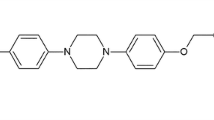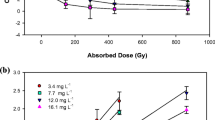Abstract
The effect of ionizing radiation on florfcnicol (FF), an antibiotic with wide antibacterial properties was investigated to determine whether it can be sterilized using high-energy radiation. FF was irradiated by E-beam radiation to doses ol 25 – 8(X) kGy, and then changes in the physico-chemical properties were examined using chromatographic methods (TLC and HPLC), spectroscopic methods (NMR and MS) and hyphenated methods (HPLC-MS). It was found that a standard sterilizing dose of 25 kGy led to the formation of two new products of radiolysis as well as lowering the content of FF by 0.95%. With higher doses of radiation, the content of FF further decreased (by 12.27% with a dose of 800 kGy). and new products of radiolysis appeared (up to five with a dose of 800 kGy). However, there were no differences between the NMR and MS spectra o( irradiated and non-irradiated samples of FF. A linear dependence was found between the dose of radiation and the FF content (correlation coefficient of 0.9951) as well as between the melting point and the sum ol products of radiolysis (correlation coefficient of 0.9975). It was found that a radiodegradation of FF took place by the breaking of an amide bond, leading to the formation of an aliphatic amine, which was subsequently oxidized to 4-methylsulfonylbenzoic acid. The radiolytic yield for the radiodegradation of FF was calculated to be 10.24 molecules/100 eV for a dose of 25 kGy. As a result of our investigation, we can conclude that FF shows a reasonably good radiostability in the range of doses used for sterilization, i.e. 25 kGy and below, and therefore it can be sterilized using high-energy radiation without changing its physicochemical, properties and hence its therapeutic efficacy.
Similar content being viewed by others
References
R. A. Sams, in Proceedings of the XVIII World Buiatrics Congress, 1994, Bologna, 13.
F. Schlunzen, R. Zarivach, J. Harms, A. Bashan, A. Tocilj, R. Albrecht, and A. Yonath, Nature, 2001, 413, 814.
O. A. Mascaretti, “Bacteria versus Antimicrobial Agents, an Integrated Approach”, 2003, ASM Press, Washington D.C.
S. Schwarz, C. Kehrenberg, B. Doublet, and A. Cloeckaert, FEMS Microbiol. Rev., 2004, 28, 519.
European Pharmacopoeia, 5th ed., 2002, Council of Europe, Strasburg.
B. Marciniec and K. Dettlaff, in “Trends in Radiation Sterilization of Health Care Products”, 2008, IAEA, Vienna, 187.
W. Bögl, Radiat. Phys. Chem., 1985, 25, 425.
M. P. Kane and K. Tsuji, J. Pharm. Sci., 1983, 72, 30.
C. Larsen and H. Bundagaard, J. Chromatogr., 1978, 147, 143.
N. Barbarian, A. S. Crucq, and B. Tilquin, Radiat. Phys. Chem., 1996, 48, 787.
N. Barbarian, B. Tilquin, and E. De Hoffman, J. Chromatogr., A, 2001, 929, 51.
K. Dettlaff, A. Tężyk, B. Marciniec, R. Wachowiak, M. Naskrent, and B. Bednarek, Chem. Anal., 2008, 53, 171.
B. Marciniec, M. Stawny, M. Hofman, and M. Naskrent, J. Therm. Anal. Calorim., 2008, 93, 733.
M. H. Vega, E. T. Jara, and M. B. Aranda, J. Planar Chromatogr., 2006, 19, 204.
B. Marciniec, K. Dettlaff, and M. Naskrent, J. Pharm. Biomed. Anal., 2009, 50, 675.
V. Hormazabal, I. Steffenak, and M. Yndestad, J. Chromatogr., A, 1996, 724, 364.
L. Hong, A. Horni, M. Hesse, and H. Altorfer, Chromatographia, 2002, 55, 13.
B. Marciniec, M. Stawny, and P. Kachlicki, to be published.
B. Marciniec, M. Kozak, M. Naskrent, K. Dettlaff, M. Ogrodowczyk, M. Stawny, and L. Wachowski, J. Therm. Anal. Calorim., 2007, 88, 337.
B. Marciniec, M. Stawny, M. Kozak, and M. Naskrent, Spectrochim. Acta, Part A, 2008, 69, 865.
P. Z. Zagórski, “Sterylizacja Radiacyjna”, 2007, IChTJ, Warsaw.
B. J. Mincher and R. D. Curry, Appl. Radiat. Isot., 2000, 52, 189.
S. Yu, B. Lee, M. Lee, I. H. Cho, and S. W. Chang, Chemosphere, 2008, 71, 2106.
D. W. Kim, K. C. Han, W. K. Lee, and S. K. Ihm, Radiat. Phys. Chem., 1996, 48, 651.
Z. P. Zagórski, Radiat. Phys. Chem., 1999, 56, 559.
M. Gibella and B. Tilquin, Analysis, 1999, 27, 657.
D. E. Holt, R. Hurley, and D. Harvey, J. Antimicrob. Chemother., 1995, 35, 115.
Author information
Authors and Affiliations
Corresponding author
Rights and permissions
About this article
Cite this article
Marciniec, B., Stawny, M., Kachlicki, P. et al. Radiostability of Florfenicol in the solid state. ANAL. SCI. 25, 1255–1260 (2009). https://doi.org/10.2116/analsci.25.1255
Received:
Accepted:
Published:
Issue Date:
DOI: https://doi.org/10.2116/analsci.25.1255




